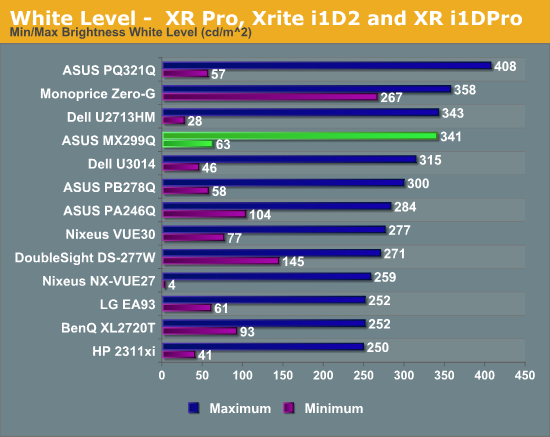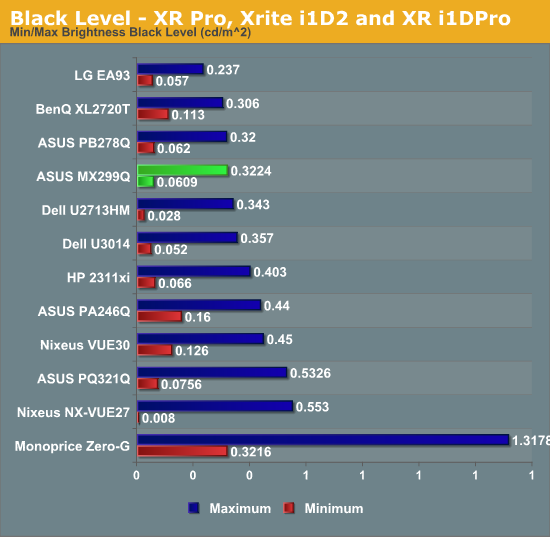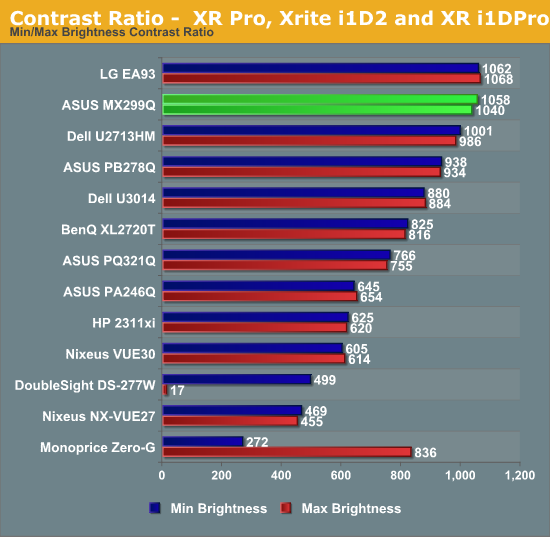ASUS MX299Q Monitor Review
by Chris Heinonen on September 23, 2013 12:00 AM ESTI usually pay little interest to the specs a manufacturer provides for contrast and brightness because they’re so easy to manipulate. Inflated contrast ratios on LED displays come from turning off the backlight and then measuring, as if we work on pure-black screens. Brightness is just as easy to mess with by pushing the panel too far. Everything is tinted and highlights are crushed, but you get a higher brightness reading that might sell. Really everyone is better off to ignore the ratings they see and instead consult with independent reviews.
ASUS manages to split the difference here by under-rating the brightness of the MX299Q but vastly overstating the contrast ratio. ASUS says the MX299Q can produce 300 cd/m^2 of brightness but I managed to produce 341 cd/m^2 from it in my testing. That should be plenty for anyone in regular use, even if you have lots of ambient light. Crank the brightness all the way down and you get 63 cd/m^2, providing you plenty of room in which to find a light level that is appropriate for your work environment.

The black level on the ASUS MX299Q is very good. Even with the backlight at maximum we see a black level of 0.3189 cd/m^2, placing it at the top of the pack. Turn the backlight to the minimum and the light output falls to a miniscule 0.0609 cd/m^2. Both of these are excellent numbers, especially for an IPS panel.

ASUS really got aggressive with their contrast rating of 80,000,000:1 on the MX299Q. The lowest black level any meter can reasonably measure is 0.0001, which would mean a peak white level of 8,000 cd/m^2. I don’t know exactly how bright that is, but I think you’ll be seeing spots or blinded if you looked at a monitor that bright. Needless to say, in practice the MX229Q (and other LCDs) get nowhere near such black levels.
The unfortunate thing is that ASUS has no reason to embellish here. Their actual contrast numbers of 1040:1 and 1058:1 are both excellent and rank among the best IPS displays that have been reviewed.

So ASUS might have been too conservative and too aggressive in their official specs for the MX299Q, but the real-world numbers are very good to see.










44 Comments
View All Comments
Icehawk - Monday, September 23, 2013 - link
Hmm, would love to see a few images from FPS to see what they look like on a 21:9 - do I get useful additional info or is everything so fishbowled or out of my direct sight that it isn't a positive?cheinonen - Monday, September 23, 2013 - link
There is a gallery in my prior 21:9 display review with some gaming images comparing 16:9 to 21:9 screen area. Those can be found here: http://www.anandtech.com/Gallery/Album/2630mdrejhon - Monday, September 23, 2013 - link
>>"The lowest black level any meter can reasonably measure is 0.0001, which would mean a peak white level of 8,000 cd/m^2."Actually, that's not quite fully accurate. Some expensive million-dollar meters can measure light at the SINGLE photon levels (Hint: They're used to detect neutrinos). There are some lab-quality meters at the thousand-dollar level that can measure less than 0.0001cd/m2. It is only a simple matter of how much you're willing to pay for a light meter.
A more scientifically accurate way to say this is "The lowest black level any _consumer_ meter can reasonably measure is 0.0001"
cheinonen - Monday, September 23, 2013 - link
I'm only referring to meters that would be used for measuring displays, like this. At the high end there is the Konica Minolta CS-2000 for $26,000 that can measure down to 0.003 cd/m2 and the Klein K10-A for $5,500 that measures down to 0.00006 cd/m2. Regardless, any contrast number out there that is past 100,000:1 and it's an OLED is playing games most likely.Wwhat - Monday, September 23, 2013 - link
In your spec listing you mention 1 Year warranty, However in the EU the minimum warranty for all electronic devices is 2 years.And incidentally, because most people are not aware of that, many shops and manufacturers pretend they are doing you a special favor by giving you 2 years warranty., but hey that's commercialism.
And some are quite incredibly rude and don't mention that fact when they try to sell you additional extended warranties, including big companies like apple I hear.
Wwhat - Monday, September 23, 2013 - link
Quite outrageous to not have VESA mounting holes on a monitor in my view, but I guess they sell anyway so it's not going to end any time soon that manufacturers do that.cbrownx88 - Monday, September 23, 2013 - link
I'd have already purchased one if this panel had VESA mounts or 120hz/lightstrobe.Larzy - Tuesday, September 24, 2013 - link
On the input lag, it isn't split up like the other screens are shown, the first segment showing input lag and the second segement showing pixel response times, but on this display is it 10ms pixel response and no input lag at all ?Larzy - Tuesday, September 24, 2013 - link
If that's true, then 9ms (rather) it's certainly one of the best 21:9 for gaming.cheinonen - Tuesday, September 24, 2013 - link
No, this has been discussed as using SMTT allowed for breaking it up into two separate measurements. Since SMTT is no longer available and the license has expired, I can't use it to test anymore. Now I just have a single lag number that encompasses both of them. It's unfortunate but the way it is.